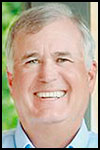Let good times roll, but beware the black swan
In the field of economics, a black swan is an unanticipated force that can disrupt a seemingly tranquil market.
The theory arose from the dot-com bubble that burst between 2000 and 2003 and the housing bubble that burst even more spectacularly in 2008, precipitating the Great Recession.
Scott Chambers, addressing the McMinnville Area Chamber of Commerce with his son, Kevin, said it’s impossible to know when the black swan will next strike or what form that strike might take. A former professor of finance at Linfield College, he claims there’s simply no way of telling.
“Will there be a catastrophic decline in the stock market sometime in the next six to eight years? Probably,” he said.
“What will cause it? I can’t tell you,” he added.
Black swans never book appearances in advance, he said, explaining, “Something we didn’t anticipate all of a sudden starts spiraling out of control.”
Chambers, who serves on the boards of Linfield College and First Federal Savings & Loan, told the crowd domestic economic news has been overwhelmingly positive of late. “The headline numbers are all really, really good in the United States,” he said.
The gross domestic product — the measure of all the goods produced in the country — now exceeds $20 trillion. “If you take that, divide by the number of people, the measure of outcome per person in the country, is $56,000,” he said.
The growth rate is 3.5 percent, he said. If that doesn’t seem outstanding, compare it to those of other countries.
“That’s better than all the other developed countries in the world,” he said. “The only place where the growth rate is exceeding that is in the developing countries of China and India.”
Many people mistakenly think China has a larger economy than the United States.
“It doesn’t,” he said. “They’re still lagging behind us. The U.S. is the premier economy and the largest in terms of economic output, followed by the European Union.”
However, China is gaining.
“If China continues on its path, it will be the world’s largest economy,” Chambers said. He added it will still take a few generations, .
If America’s gross domestic product is impressive, so is its debt load of approximately $22 trillion. But Chambers said, “We’re not that far out of the league of everyone else.
“People worry about debt, and I worry about the debt load on the U.S. economy. But our economy is growing. As long as our economy grows, that’s a reasonable amount of U.S. debt we’re carrying.”
Black swans can assume many forms. They may, for example, appear as tariffs stemming from President Donald Trump’s ongoing trade wars with China and the European Union.
Chambers said it’s currently in a state of ceasefire, while the administration regroups following the first round. If trade war re-ignites, he said, Oregon could be particularly affected.
The state’s $200 billion gross domestic product depends heavily on trade, particularly with China. Chambers said Intel and the Port of Portland are especially vulnerable.
However, he said none of that information should overshadow the positive economic news, both regionally and nationally, with an unemployment rate below 4 percent.
“That is phenomenal to have that low an unemployment rate,” Chambers said. “We haven’t seen that low of an unemployment rate in the United States for close to 50 years.”
By comparison, the unemployment rate stands at 12 percent in Spain and 8 percent in the European Union as a whole.
Oregon’s unemployment rate is currently about 4.3 percent.
But Chambers said, “That’s a bit deceptive, because our unemployment rate in Yamhill County is below the national average. The metro area is below the national average.”
The state rate ranks higher, he said, because “we still have some outlying counties that are struggling.” He cited an unemployment rate of 8 percent in Harney County as an example.
For the most part, Chambers said, Oregonians west of the Cascades are faring better.
“There’s a lot of opportunity in the United States right now,” he said. “You graduate from high school, you can get a job. You graduate from Linfield College, there’s a job out there for you.”
The outlook appeared less rosy last year.
U.S. stock markets lost money. Internationally, shares decreased 14 percent in value.
Chambers said the problems originated from worries about trade wars and turmoil within the European Union.
“We started in the fall last year getting into a real snit about trade and tariffs,” he said. “So 2018 was not a good year in financial markets. But 2019 is a great lesson in why you never overreact when markets are in decline.”
Financial markets fully recovered during the first two months of 2019, as the market rose 11 percent, he said.
Then again, one never knows.
“Anyone who thinks they can time that, when to get in and out, is dreaming,” Chambers observed. “As long as you’re well-positioned in the market, it comes back. And when it comes back, it comes back in a spectacular fashion.”
Inflation could slow the economy, as could interest rates.
Chambers mentioned one particularly suspicious swan in the lake.
“What’s really exploded is the amount of student loans out there,” he said. “That has me worried.”
More than 44 million U.S. college graduates collectively owe $1.5 trillion, which averages to $35,000 each.
How can people pay that amount of debt? Odds are, they can’t, Chambers said.
The delinquency rate on student loans is already 10 percent. What’s more, people burdened with crushing debt don’t buy homes or make other large investments.
“The biggest increase in debt over the past few years has been student loans,” Chambers said. “As a nation, we have a problem, and it’s going to take some creativity to address the problem,” he said.
Son Kevin Chambers said entering the job market during the bursting of the dot-com and housing bubbles have made his fellow young adults nervous. And the loan burden adds to that uncertainty.
“A lot of the stereotypes we have about Millennials are based on the hand they were dealt as they entered adulthood,” he said. “Millennials are very risk-averse, probably the most risk-averse generation we’ve had.”
The younger Chambers also said people have an unfair image of millennials in general.
“It’s not that people born after 1980 are narcissists,” he said. “It’s that young people are narcissists.”










Comments